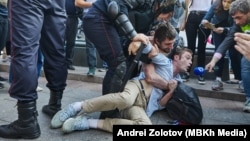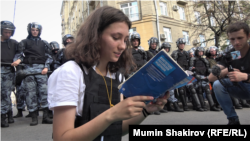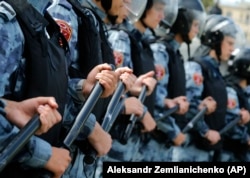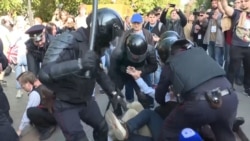The warning, from the U.S. Embassy in Moscow, resembled countless others before it.
Addressed to U.S. citizens living in the Russian capital, the August 2 message warned of an unauthorized protest and a likely heavy police presence, suggesting that Americans avoid the area.
This post, however, was also accompanied by a Russian-language map, copied from a Facebook page by the organizers of the protest, showing the planned route of the march and calling it a “stroll” -- a word that opposition groups have used to avoid calling similar actions protests or demonstrations.
That, according to the Russian Foreign Ministry, amounted to U.S. interference in Russian affairs.
"The U.S. Embassy in Moscow has been actively involved in [our] domestic affairs; it published a detailed map, showing the [protest] route, a so-called stroll,” Maria Zakharova, the ministry’s spokeswoman, told state-run television on August 4, the day after the event.
The Moscow protests, and the push by government critics to run in next month’s city council elections, are shaping up as a showdown between the opposition and the authorities – both in the capital and in President Vladimir Putin’s Kremlin. Two successive Saturdays have seen a sizable turnout of demonstrators, met with a brutal police crackdown that has swept up participants and bystanders alike.
For Russia’s small and increasingly beleaguered opposition, what’s key is how their efforts are perceived: exercising their constitutionally guaranteed right to free assembly, and their insistence that their city council candidates are explicitly following the rules to stand in the September 8 election.
On state TV, that’s not how it’s being portrayed.
State newscasts ignored the first big protest on the day it occurred -- July 27 -- even as more than 1,300 people ended up being detained, and imagery and video from the event was broadcast widely on social media, Western outlets, and the dwindling number of independent Russia media.
One day later, however, Vladimir Solovyov, a well-known TV host on state-run channel Rossia, alleged that organizers had recruited people from outside of Moscow in an effort to provoke a police response and generate sympathetic news coverage.
"This means that there was active recruiting of all possible potential lawbreakers, who came to Moscow with only one task: to arrange actions for the Western press, for social networks, and to show how they believe that they are in charge here," he said.
The “in charge” wording may have been a play on protest slogans such as “It’s our city” and “We are the authorities.”
That same day, REN TV, which is controlled by Kremlin-allied business figures, broadcast a report saying that would-be candidates for the Moscow City Duma election had opted to not participate in the demonstrations and instead hired others to protest in their stead.
The report suggested that some opposition leaders had ties to U.S. intelligence and that organizers had tried to entice some people to attend by offering free pet food to people with pets.
Another segment in the report focused on a man who appeared to be Ukrainian, who drew parallels to Ukraine’s 2013-14 Euromaidan protests. Those protests ousted a Moscow-friendly Ukrainian president and have been consistently portrayed by Russian state media as being the work of a “fascist junta.”
Five days later, on July 29, REN TV broadcast another report, asserting that it had uncovered a nefarious and meticulous plot hatched by people from outside of Moscow.
“The TV channel managed to find out that the spontaneous protests were well organized and coordinated,” the channel’s newscaster said. “At the head of the protests were young teams, distributing teams, which, in turn, were supervised by social-network managers and instant messengers.”
Days before the next round of protest on August 3, Moscow Mayor Sergei Sobyanin, speaking on city-owned station TV Tsentr (below), asserted that protesters were plotting to storm city hall and that their actions provoked police to take violent and harsh measures. Organizers and observers said both those claims were false.
On August 3, one newscaster on Rossia TV offered a passing editorial comment, suggesting that participants who attended along with their children were irresponsible: “Some participants even showed up pushing baby strollers, apparently not worrying about the safety of their children.”
Conspiracies of foreign intelligence agency meddling have also trickled down to the precinct level for Moscow police. One man who was detained during the protests, even though he said he was merely a bystander, was berated by an officer during his two days in police custody.
“Guys, you understand nothing. You’re being controlled. It’s the CIA that is manipulating you,” the man, Mikhail Bykanov, recalled the officer as saying. “The protests are just the beginning. This is part of a protracted campaign to oust the regime and seize Russia’s resources.”
And then there was the assertion from Zakharova about U.S. interference in Russia’s domestic affairs. It’s a statement that echoed Kremlin assertions going back to 2011-12, during a wave of street protests fueled by anger over evidence of election fraud and dismay at Putin’s decision to return to the presidency after a stint as prime minister.
At the time, Putin accused then-Secretary of State Hillary Clinton of giving a “signal” to Russian activists and the U.S. State Department of encouraging their “active work.”
At least one newscast has also sought to portray Russian riot police officers as being victims of brutal violence at the hands of protesters. That, too, is an echo of the 2011-12 protests, when several Russian activists were accused of injuring police by throwing objects such as chunks of asphalt.
On August 3, NTV, a once-independent channel that is now controlled by the Russian natural-gas giant Gazprom, reported on an anonymous post to Twitter that called for protesters to target the relatives or children of riot police.
The channel also republished a letter that circulated on Instagram, ostensibly written by Russian law enforcement officers, that called for targeting the children of protest organizers. The letter also asserted that demonstrators were receiving foreign funding.
“Not for the first time, we have looked death in the face, defending the interests of our Motherland,” the letter said. “We have the will and determination to punish those who betray it.”
Amid the struggle for how the protest movements should be portrayed, the word “stroll” itself has taken on political connotations: the anti-corruption crusader Aleksei Navalny and his allies now use the word to describe their street actions in an effort to thwart official prohibitions on unauthorized demonstrations -- that is, “strolling” isn’t illegal.
A U.S. Embassy spokeswoman did not respond to messages seeking comment.











